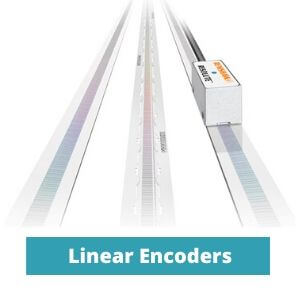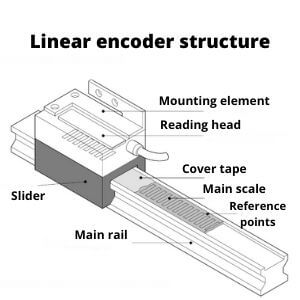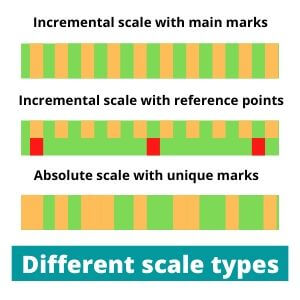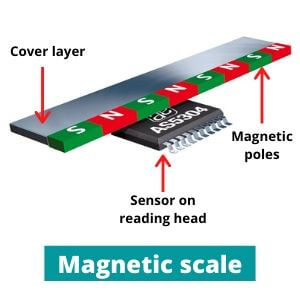21.06.2020
CONTENTS:
Linear encoder is a sensor or transducer that measures linear movement of an object. The device can move in different directions but always travels along one axis. It can detect speed, distance, direction, and displacement.
However, there is a special type that works with the use of this method with diameters or round objects. It is called Ring encoders.
Simple structure of linear encoder consists of signal unit (located in slider) that linked to measuring scale. We can divide it into 3 basic elements depending on functional purposes:.
Scale is one of the most important details. The accuracy and operation method strongly depend on its design.
This part has special marks on its surface that help the sensing system to determine its current position. Such labels are offset from each other by a certain distance. The more a number of such marks and the denser they are placed, the higher the resolution.
To work with small values, all encoder elements are mounted in one case. To operate at long distances (from 2 meters to 50 or even more) a special tape (strip) is used. That strip is installed separately from the sensor system. That is why it is made from durable materials such as stainless steel. If you need more information about how does a linear strip work, check the article Linear encoder tape.
Reading-head moves along scale entire length like a train on a railway.
Signal source sends a pulse that passes through the scale. When it moves through scale’s marks, the pulse is distorted depending on the type of mark. The sort of signal depends on the working principle. This is discussed in more detail below. The most popular technologies are optical and magnetic.
In this article, we examined two basic principles of operation, however, there are a number of others (capacitive, mechanical, etc.). You can read about it here: Different types of encoders.
Transducer is a receiver where the changed signal goes. It converts information about position into digital or analog signals. Then received data moves to connected PLC through wiring via several interfaces (PROFINET, Ethernet, etc.).
Linear encoder resolution calculation occurs by counting pulses in relation to distance. In Eltra products, it is measured in millimeters between the marks. According to the measuring principle, two main types of feedback are known: incremental and absolute.
Absolute linear encoder may accurately determine the current position of reading head. On the scale, all marks have a unique position code. When the signal passes through them and arrives at the receiver, it indicates unique information about slider displacement. For example, if the resolution is 1 mm, then in this case a signal from positions of 50 mm and 51 mm will differ from each other.
 Most often, absolute linear encoders are used in systems where a specific and accurate displacement are required:
Most often, absolute linear encoders are used in systems where a specific and accurate displacement are required:
Sometimes for the same equipment, a different feedback technology is suitable. It primarily depends on the task.
Incremental linear encoder detects the position offset relative to specific points. The main marks on the scale are identical to each other. When device is turned off, the latest location status information disappears. That is why it needs some special points to navigate on the scale surface. Such points can be reference or starting (so-called zero points).
Only they encoded location information. The distance is determined relative to the removal from these points.
Such devices are often used to perform simple operations where a particular angle is not so important:
You can read more about both measurement methods in our article Incremental vs absolute encoder.
At first, it is worth saying that both magnetic and optical encoders can be incremental or absolute.
Magnetic linear encoder uses a magnetic reader head for analyzing changes in magnetic fluxes for displacement analysis. Its scale consists of a set of poles (north and south) that are magnetically coded. They are arranged in a specific way depending on the type of strip (incremental or absolute).
When a slider passes through each pole on the magnetic tape, the sensor reads current changes in the magnetic fields. After that, the transducer compares all received data with the coded position. A sensing task usually performs by a Hall sensor.
The main advantages of magnetic units are their reliability and non-contact way of working.
Such equipment has good resistance to:
It also has long service life, so it is most often used in harsh environmental conditions (in contaminated and humid areas, etc.). However, such units are quite sensitive to another magnetic interference.
Optical linear encoder uses light beams or lasers as a signal. To improve the quality and direction of light pulses additional elements are also installed into design (lens, scanning reticles, etc.)
To do this, transparent (clearance) or opaque areas are placed on the scale as marks. The optical scale is usually made from glass or plastic, sometimes from aluminum. Optical technology allows linear measurements with the greatest accuracy and high resolution.
However, pollution or solid particles in a gap between measuring surface and sensor as well as mechanical shocks and vibration can significantly affect the accuracy. Therefore, such devices should be used in conditions with small risk of mechanical shocks and factors affecting the light signal.
Conclusion: Linear encoder is the best sensor for linear measure. So, what has more accurate feedback linear or rotary encoder? It all depends on the density of labels. The method of linear equipment operation is similar to rotary encoders, but instead of a wheel, they use a scale. The most suitable model is selected depending on the tasks and environmental conditions.
We are Eltra encoder distributor and on our website you can buy low-cost Eltra linear encoders. Despite the low price, they are reliable and have a long lifespan. Our managers will help you to pick a right encoder. Check out!